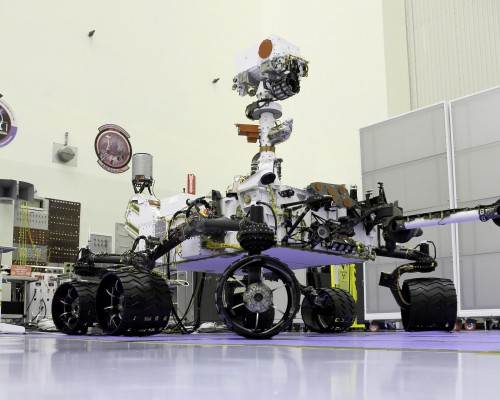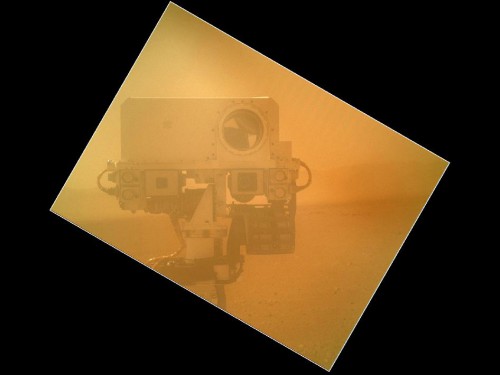
The Mars Science Laboratory rover trolling the dusty plains of the Red Planet has spotted evidence that provides one more bit of proof that Mars was once a wet world. This evidence pertains to water-bearing minerals that were discovered in rocks that were in the vicinity of clay minerals inside of a rock that Curiosity drilled into.
The team at NASA’s Jet Propulsion Laboratory (JPL) in Pasadena, Calif., announced last week that the powder that was extracted and analyzed (Curiosity has an on-board chemistry lab) indicates that Mars once had conditions that would have made it possible to support microbial lift. The announcement was made at the Lunar and Planetary Science Conference in The Woodlands, Texas, Monday, March 18.

Researchers have not, however, based their conclusions from just one piece of evidence. The team directed Curiosity to use an infrared-imaging capability camera that the rover has among its suite of various scientific equipment. They also used an instrument on the one-ton rover to shoot neutrons into the Martian surface in search of hydrogen. They also have discovered more hydration (the process of being soaked in water) in other minerals that surround the clay-bearing rock that was drilled into earlier.
“Some iron-bearing rocks and minerals can be detected and mapped using the Mastcam’s near-infrared filters,” said Jim Bell, a member of the team of scientists that are directing Curiosity’s scientific mission.
The Mast Camera, or Mastcam as it is more commonly known as, is affixed to what the public would view as the rover’s “face.”
Scientists use the Mastcam to determine whether or not water has played a part in the formation of the surrounding terrain by looking at the ratios of brightness in different wavelengths of near-infrared light from the ground. This can then be used to identify hydrated materials.
The area in which Curiosity was in February of this year is known as “Yellowknife Bay,” and it was here that Curiosity drilled into the rock with the clay compounds. The rover made history by sampling the first powder from the inside of a Martian rock.
“With Mastcam, we see elevated hydration signals in the narrow veins that cut many of the rocks in this area,” said Melissa Rice of the California Institute of Technology (Caltech). “These bright veins contain hydrated minerals that are different from the clay minerals in the surrounding rock matrix.”
Curiosity’s chassis has a suite of scientific instruments, and not all of them originated in the United Sates. One of these, the Russian-built Dynamic Albedo of Neutrons, or “DAN,” has been used to seek out hydrogen underneath Curiosity. Finding water on Mars is far more difficult than it is here on Earth. Mars is a flash-frozen world, with about one percent of Earth’s atmosphere—most of that is carbon dioxide. Any water exposed to the surface would not remain there.
Curiosity’s researchers have directed DAN to seek out water that is locked up in rocks and minerals.

“We definitely see signal variation along the traverse from the landing point to Yellowknife Bay,” said DAN Deputy Principal Investigator Maxim Litvak with Moscow’s Space Research Institute. “More water is detected at Yellowknife Bay than earlier on the route. Even within Yellowknife Bay, we see significant variation.”
The international flavor of Curiosity’s scientific effort became further apparent when more findings were revealed as having coming from the Canadian-built Alpha Particle X-ray Spectrometer, or “APXS.” This instrument is located on the rover’s arm. The story from APXS is that while the area might have once been wet, it did little to alter the chemical elements that are located in this section of Gale Crater.
“The elemental composition of rocks in Yellowknife Bay wasn’t changed much by mineral alteration,” said Mariek Schmidt, a Canadian member of Curiosity’s science team.
The rock outcrop that Curiosity was directed to drill into is considered to be a basalt. This type of rock is the most common that is found on the Red Planet.
As highlighted earlier, Mars is a dusty world. APXS could not get a perfect match for a basalt—that is, until after the rover dusted off the rock. Interestingly, when APXS took a second pass of the rock, it detected less sulfur.
“By removing the dust, we’ve got a better reading that pushes the classification toward basaltic composition,” Schmidt said.
While basaltic rocks might be somewhat interesting, it is really sedimentary rocks that tell the story that scientists want to hear. Sedimentary rocks are formed when basaltic rocks are broken down and then transported and modified mineralogically by water.
Curiosity is a nuclear-powered rover that was launched in November 2011 from Cape Canaveral Air Force Station in Florida on a two-year mission to determine if Mars was ever capable of supporting microbial life. The rover has ten scientific instruments and touched down on the Red Planet in August 2012.




Thank you for the great update on Curiosity Jason. AmericaSpace is without a doubt THE site for space exploration news and views. Perhaps “the international flavor of Curiosity’s scientific effort” as shown by a Russian Dynamic Albedo of Neutrons (DAN) instrument and the Canadian Alpha Particle X-Ray Spectrometer (APXS) on an American Curiosity rover is a portent of what is to come. Space exploration is expensive, with human exploration even more so. Aside from popular fantasy of a “for profit” human Mars mission sponsored by soft drink and potato chip manufacturers with additional funding from a reality show eager to send one of the Kardashians or Lindsay Lohan to Mars, it may very well take a multi-national effort to pool financial and scientific resources. Cooperation would also avoid wasteful duplication of efforts. Although there was a space race, many people felt that the heroic Apollo 11 crew did indeed land on the Moon “for all mankind.” I just want to see human exploration of the Moon, Mars and beyond. If only there was a fraction of the enthusiasm for Mars as there is for March Madness. Oh well . . . .
…and the discoveries continue…what an interesting and exciting time in the exploration of Mars. The international flavor of Curiosity represents mankind’s insatiable desire to understand what’s “out there.” As I stated earlier, the best is yet to come!
From your lips to God’s ear, Tom!
Curiosity’s mission: Accomplished! (in just 7 months!). And we’re barely started!
“We have found a habitable environment which is so benign and supportive of life that probably if this water was around, and you had been on the planet, you would have been able to drink it”
– John Grotzinger
“A fundamental question for this mission is whether Mars could have supported a habitable environment. From what we know now, the answer is yes.”
– Michael Meyer
These two statements from Curiosity’s scientists are constantly sending shivers up and down my spine!!